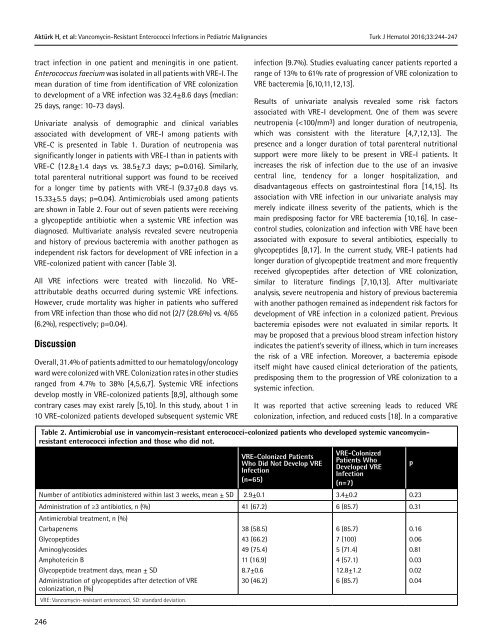Turkish Journal of Hematology Volume: 33 - Issue: 3
You also want an ePaper? Increase the reach of your titles
YUMPU automatically turns print PDFs into web optimized ePapers that Google loves.
Aktürk H, et al: Vancomycin-Resistant Enterococci Infections in Pediatric Malignancies<br />
Turk J Hematol 2016;<strong>33</strong>:244-247<br />
tract infection in one patient and meningitis in one patient.<br />
Enterococcus faecium was isolated in all patients with VRE-I. The<br />
mean duration <strong>of</strong> time from identification <strong>of</strong> VRE colonization<br />
to development <strong>of</strong> a VRE infection was 32.4±8.6 days (median:<br />
25 days, range: 10-73 days).<br />
Univariate analysis <strong>of</strong> demographic and clinical variables<br />
associated with development <strong>of</strong> VRE-I among patients with<br />
VRE-C is presented in Table 1. Duration <strong>of</strong> neutropenia was<br />
significantly longer in patients with VRE-I than in patients with<br />
VRE-C (12.8±1.4 days vs. 38.5±7.3 days; p=0.016). Similarly,<br />
total parenteral nutritional support was found to be received<br />
for a longer time by patients with VRE-I (9.37±0.8 days vs.<br />
15.<strong>33</strong>±5.5 days; p=0.04). Antimicrobials used among patients<br />
are shown in Table 2. Four out <strong>of</strong> seven patients were receiving<br />
a glycopeptide antibiotic when a systemic VRE infection was<br />
diagnosed. Multivariate analysis revealed severe neutropenia<br />
and history <strong>of</strong> previous bacteremia with another pathogen as<br />
independent risk factors for development <strong>of</strong> VRE infection in a<br />
VRE-colonized patient with cancer (Table 3).<br />
All VRE infections were treated with linezolid. No VREattributable<br />
deaths occurred during systemic VRE infections.<br />
However, crude mortality was higher in patients who suffered<br />
from VRE infection than those who did not (2/7 (28.6%) vs. 4/65<br />
(6.2%), respectively; p=0.04).<br />
Discussion<br />
Overall, 31.4% <strong>of</strong> patients admitted to our hematology/oncology<br />
ward were colonized with VRE. Colonization rates in other studies<br />
ranged from 4.7% to 38% [4,5,6,7]. Systemic VRE infections<br />
develop mostly in VRE-colonized patients [8,9], although some<br />
contrary cases may exist rarely [5,10]. In this study, about 1 in<br />
10 VRE-colonized patients developed subsequent systemic VRE<br />
infection (9.7%). Studies evaluating cancer patients reported a<br />
range <strong>of</strong> 13% to 61% rate <strong>of</strong> progression <strong>of</strong> VRE colonization to<br />
VRE bacteremia [6,10,11,12,13].<br />
Results <strong>of</strong> univariate analysis revealed some risk factors<br />
associated with VRE-I development. One <strong>of</strong> them was severe<br />
neutropenia (

















